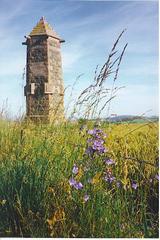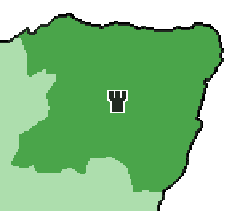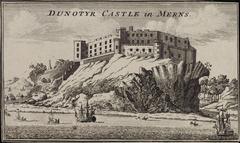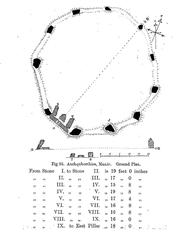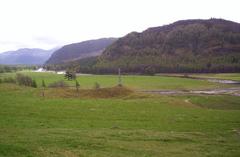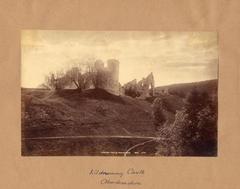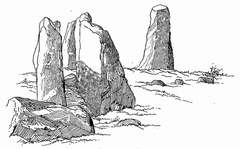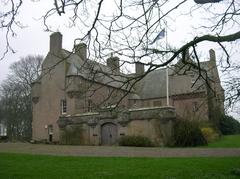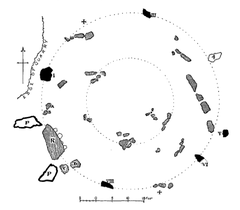Racquets Court at Fyvie Castle: Visiting Hours, Tickets, and Visitor Guide
Date: 14/06/2025
Introduction
Fyvie Castle, nestled in the rolling landscapes of Aberdeenshire, Scotland, is celebrated for its majestic architecture, storied past, and expansive grounds. Among its most intriguing features is the Racquets Court—also known as “The Playhouse”—a unique example of Edwardian leisure architecture. This guide provides a comprehensive overview of the Racquets Court’s history, architectural significance, current restoration status, and all you need to know to plan a memorable visit to Fyvie Castle.
Historical Background
Origins and Patronage
The Racquets Court was commissioned in 1903 by Alexander Forbes-Leith, following his acquisition of Fyvie Castle in 1885. Influenced by his American wife, Marie Louise January, the court reflects a fusion of Scottish Baronial style with American leisure trends—a testament to the cosmopolitan tastes of the Forbes-Leith family. The court features an imported skittles alley, further underscoring the family’s international connections and commitment to modernizing the estate (National Trust for Scotland; Historic Environment Scotland).
Social and Cultural Context
In the early 20th century, country estates like Fyvie were centers for both elite social gatherings and new forms of recreation. The Racquets Court served as a venue for sport and entertainment, complete with a viewing platform for spectators. The addition of the skittles alley reflected the family’s interest in international leisure pursuits and made the court a hub for both athletic competition and socializing (National Trust for Scotland).
Later History and Conservation
Fyvie Castle remained under Forbes-Leith family stewardship until 1984, when it was entrusted to the National Trust for Scotland. Restoration has been ongoing, especially following significant damage from Storm Otto in 2023. The Racquets Court is undergoing repair, with reopening planned for late 2025 (Castrum to Castle; National Trust for Scotland).
Architectural Features
Style and Exterior
The Racquets Court is built in the Scottish Baronial style, featuring crenellated parapets and bartizans that echo the main castle. Harled walls with red sandstone dressings and decorative Italian marble panels articulate the building’s exterior, emphasizing both durability and aesthetic richness. Notably, a carved Italian marble fountain in a blind Gothic window adorns the south gable, blending Gothic and Renaissance influences (Historic Environment Scotland).
Roof and Windows
The court’s pitched roof and clerestory windows allow for ample natural light. The original glass roof, damaged in 2023, is currently under restoration (National Trust for Scotland).
Interior Layout
The interior was designed to American racquets court dimensions and includes a viewing platform for guests. The adjacent skittles alley is a rare find in Scotland and features original imported equipment (Historic Environment Scotland).
Craftsmanship
The use of high-quality materials such as Italian marble and red sandstone, along with expert stone carving, illustrates the wealth and taste of the original owners.
Setting and Relationship to the Castle
Set amidst the landscaped gardens, the Racquets Court complements the Baronial style of Fyvie Castle and offers views of the gardens and loch (Discover Scottish Gardens).
Heritage Status
The Racquets Court is a listed building protected under Scottish heritage law, ensuring careful restoration and ongoing preservation (Historic Environment Scotland).
Visitor Information
Visiting Hours and Tickets
- Opening Hours: Typically 10:00 AM to 5:00 PM, with last entry at 4:00 PM. Hours may vary seasonally; always check the National Trust for Scotland website for current details.
- Ticket Prices: As of 2023, adult tickets are £15.50, concessions £12.00, and family tickets start at £30.00. National Trust for Scotland members enjoy free admission and parking (24 Countries).
How to Get There and Accessibility
- Location: Fyvie Castle is located roughly 25 miles northwest of Aberdeen. The estate is most easily reached by car, as public transport options are limited.
- Parking: Ample on-site parking is available; free for NTS members.
- Accessibility: The main castle, gardens, shop, and tearoom are accessible to most visitors. Some historic areas and the Racquets Court may have uneven surfaces or steps. For up-to-date accessibility information, consult the NTS (Explore Aberdeen).
Facilities and Amenities
- Restrooms: Located near the entrance and inside the castle.
- Café/Tearoom: Open during castle hours, serving light meals and refreshments.
- Gift Shop: Sells souvenirs, books, and local products.
- Picnic Areas: Available in scenic spots, including near the lochside.
Special Events and Guided Tours
The National Trust for Scotland periodically offers themed tours and events that may include access to the Racquets Court. These events highlight the sporting and social history of the estate and may feature expert talks, demonstrations, or seasonal activities. Check the official website or inquire on arrival for the latest schedule (National Trust for Scotland).
Restoration Update: Storm Otto and the Racquets Court
In February 2023, Storm Otto caused significant damage to the Racquets Court, particularly to its glass roof and surrounding masonry. The National Trust for Scotland immediately began emergency stabilization and restoration, aiming for a full reopening in late 2025. The restoration prioritizes historical authenticity and visitor safety, with updates provided on the NTS website (National Trust for Scotland).
Photography Tips
The Racquets Court, with its striking design and scenic gardens, is a favorite among photographers. For optimal lighting, visit during early morning or late afternoon. The walled garden, lochside, and other estate features also offer superb photographic opportunities. Please avoid flash photography inside the castle and respect any signage.
Nearby Attractions
Fyvie Castle is part of the wider Aberdeenshire heritage landscape. Other notable sites include:
- Drum Castle
- Crathes Castle
- Haddo House
- Huntly Castle
- Cairngorms National Park
These destinations offer additional insights into Scottish history and are ideal for day-trips or extended tours (24 Countries).
Frequently Asked Questions (FAQ)
Q: What are the visiting hours for Fyvie Castle?
A: Typically 10:00 AM to 5:00 PM, with last entry at 4:00 PM. Check the NTS website for seasonal changes.
Q: How much are tickets?
A: Adult tickets are £15.50, with concessions and family pricing available. NTS members enter free.
Q: Is the Racquets Court open to the public?
A: Access is limited during restoration. The court is visible from the grounds, and staff can provide current access information.
Q: Is Fyvie Castle accessible for those with mobility issues?
A: Most main areas are accessible, though some historic sections may present challenges. Contact the NTS for detailed accessibility guidance.
Q: Can I book guided tours?
A: Yes, guided tours are available during the main visitor season and can be booked in advance.
Practical Visitor Tips
- Plan Ahead: Check opening hours, restoration updates, and ticket options online.
- Dress Appropriately: Scottish weather can be unpredictable; bring suitable clothing and sturdy footwear.
- Supervise Children: The estate is family-friendly but keep an eye on children near water and historic structures.
- Support Conservation: Consider making a donation or joining the NTS to support ongoing restoration projects.
Contact and Further Information
Fyvie Castle and Estate
Fyvie, Turriff, Aberdeenshire, Scotland, UK, AB53 8JS
Tel: +44 01224 212266
National Trust for Scotland – Fyvie Castle
For the latest restoration updates and event information, consult the NTS website or follow Fyvie Castle on social media.
Summary
The Racquets Court at Fyvie Castle is a rare survivor of Edwardian sporting architecture, reflecting the cosmopolitan tastes and social life of Scotland’s aristocracy. Despite recent storm damage and ongoing restoration, the court remains a central part of the Fyvie Castle experience. Visitors can explore the castle’s rich history, enjoy its beautiful grounds, and participate in guided tours and special events. By planning ahead and staying informed via the National Trust for Scotland, you can ensure a memorable and enriching visit to one of Aberdeenshire’s most remarkable heritage sites.
Sources and Further Reading
- Historic Environment Scotland
- National Trust for Scotland: Storm Damage at the Fyvie Racquets Court
- National Trust for Scotland: Storm Otto Causes Significant Damage at Fyvie Castle
- Castrum to Castle
- Explore Aberdeen
- Secret Scotland
- 24 Countries
- Discover Scottish Gardens
